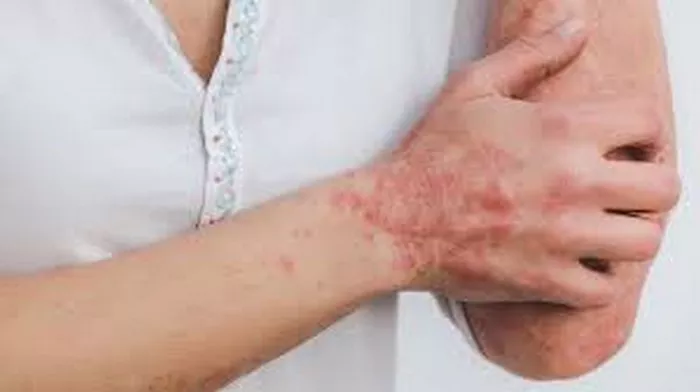Foot psoriasis is a common skin disorder characterized by rapid skin cell production that leads to thick, scaly patches on the feet. It can significantly affect daily activities and quality of life.
What Does Foot Psoriasis Look Like?
Foot psoriasis presents with several distinctive features, which can vary in severity:
Red Patches
The initial signs of foot psoriasis often include red patches on the soles and tops of the feet. These areas can be:
Well-defined: The edges are usually clear and distinct from surrounding skin.
Raised: The patches may feel elevated compared to the surrounding skin.
SEE ALSO: Hidradenitis Suppurativa: Why Does It Happen?
Scaling
The red patches are typically covered with silvery-white scales, which can vary in thickness:
Flaky Appearance: The scales may flake off easily, leaving the underlying skin exposed.
Thickened Skin: In chronic cases, the skin may thicken, resulting in a rough texture.
Cracks and Fissures
Severe psoriasis can cause painful cracks in the skin, particularly on the heels and the sides of the feet:
Bleeding: These cracks can bleed, leading to discomfort and increased risk of infection.
Pain: Walking may become painful due to the fissures, making daily activities challenging.
Pitted Nails
Psoriasis can affect toenails, leading to changes in their appearance:
Pitting: Small depressions may develop on the surface of the nails.
Discoloration: Nails may become discolored, turning yellow or brown.
Nail Lifting: In severe cases, nails can lift from the nail bed, leading to further discomfort.
Itching and Burning Sensations
Patients often report itching and burning sensations, particularly during flare-ups:
Irritation: These sensations can cause significant discomfort and may lead to scratching, which can worsen the condition.
Types of Foot Psoriasis
Several types of psoriasis can affect the feet:
Plaque Psoriasis
This is the most common type and is characterized by:
Raised Red Patches: Covered with silvery scales, they often occur on the tops of the feet and the soles.
Guttate Psoriasis
Often triggered by infections, it features:
Small Lesions: Drop-shaped spots that can appear suddenly, usually on the trunk, limbs, and sometimes the feet.
Inverse Psoriasis
Common in skin folds, it appears as:
Smooth, Red Lesions: Often seen between the toes, without the scaling typically associated with other types.
Nail Psoriasis
This affects the toenails specifically and includes:
Pitting and Discoloration: Nails may crumble or detach from the nail bed.
Causes of Foot Psoriasis
While the exact cause is not fully understood, several factors contribute to its development:
Genetics
A family history of psoriasis increases the likelihood of developing the condition. Specific genes have been identified that may predispose individuals to psoriasis.
Immune System Dysfunction
Psoriasis is considered an autoimmune disorder where the immune system mistakenly attacks healthy skin cells, leading to rapid skin cell turnover.
Triggers
Understanding triggers is essential for managing flare-ups:
Stress: Emotional stress can worsen symptoms and lead to flare-ups.
Skin Injuries: Cuts, scrapes, or sunburn can trigger new lesions.
Infections: Conditions like strep throat can precipitate guttate psoriasis.
Weather Changes: Cold, dry weather often aggravates symptoms, while humidity may provide relief.
Certain Medications: Drugs like lithium or beta-blockers can exacerbate psoriasis.
Diagnosis of Foot Psoriasis
If you suspect you have foot psoriasis, a prompt diagnosis is crucial. Healthcare professionals typically follow these steps:
Physical Examination
A thorough examination of the affected areas allows the doctor to identify characteristic features of psoriasis.
Medical History
Providing a detailed medical history, including family history of skin disorders and any recent infections or injuries, aids in diagnosis.
Skin Biopsy
In some cases, a small skin sample may be taken to confirm the diagnosis. This helps differentiate psoriasis from other skin conditions like eczema or fungal infections.
Treatment Options for Foot Psoriasis
Treating foot psoriasis often requires a multifaceted approach tailored to individual needs and severity:
Topical Treatments
These are often the first line of defense:
Corticosteroids: These anti-inflammatory creams or ointments help reduce redness and scaling. Stronger formulations may be needed for thick patches.
Vitamin D Analogues: Medications like calcipotriene slow down skin cell growth. They are often used in conjunction with corticosteroids.
Coal Tar: Available in various formulations (shampoos, ointments), coal tar can reduce scaling and itching but may have a strong odor.
Phototherapy
Phototherapy involves controlled exposure to ultraviolet (UV) light:
UVB Light Therapy: This type of treatment helps reduce inflammation and scaling. It can be administered in a dermatologist’s office.
PUVA Therapy: This combines a medication called psoralen with UVA light therapy. It is often used for more severe cases.
Systemic Treatments
For moderate to severe cases, systemic medications may be necessary:
Methotrexate: This immunosuppressant helps slow down skin cell production and reduces inflammation.
Biologics: These are newer drugs that target specific parts of the immune system. Examples include adalimumab, etanercept, and ustekinumab. They are effective for severe psoriasis and can lead to long-lasting remission.
Lifestyle Modifications
Making certain lifestyle changes can help manage foot psoriasis:
Moisturizing: Regularly applying a good moisturizer can help keep skin hydrated and reduce scaling. Look for thick creams or ointments.
Foot Care: Keep feet clean and dry to prevent fungal infections. Use antifungal powders if necessary, especially between the toes.
Diet and Exercise: Eating a balanced diet rich in omega-3 fatty acids, fruits, and vegetables can support skin health. Regular physical activity helps reduce stress and improve overall well-being.
Living with Foot Psoriasis
Managing foot psoriasis can be challenging, but there are strategies to cope with the condition:
Comfortable Footwear
Choose Proper Shoes: Select shoes that provide ample support and allow the feet to breathe. Avoid tight-fitting footwear to prevent irritation.
Stay Active
Engage in Low-Impact Activities: Activities like swimming or cycling are less likely to irritate the feet while providing exercise benefits.
Support Networks
Join Support Groups: Connecting with others who have psoriasis can provide emotional support and practical advice for managing symptoms.
Educate Yourself
Stay Informed: Learn about psoriasis, treatments, and coping strategies. Knowledge empowers you to make informed decisions about your health.
Conclusion
Foot psoriasis is a complex condition that can impact various aspects of life. By understanding its appearance, causes, and treatment options, individuals can take proactive steps to manage their symptoms. If you experience signs of foot psoriasis, consulting a healthcare professional is crucial for proper diagnosis and treatment. With the right approach, it is possible to live a fulfilling life despite the challenges of psoriasis.
Related topics:



























